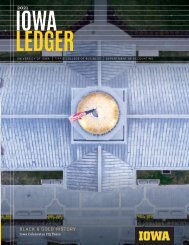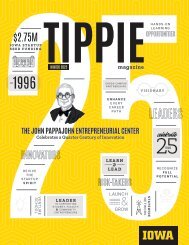Tippie Magazine (Spring 2023) - Tippie College of Business
Tippie Magazine, a semiannual publication for alumni and friends of the Tippie College of Business, includes feature stories, alumni updates, and the latest news from the college.
Tippie Magazine, a semiannual publication for alumni and friends of the Tippie College of Business, includes feature stories, alumni updates, and the latest news from the college.
You also want an ePaper? Increase the reach of your titles
YUMPU automatically turns print PDFs into web optimized ePapers that Google loves.
BLISTERING SPEED
BY TOM SNEE
Formula One was for many years the forgotten child of
automobile racing in the United States.
The European-based circuit has always been well behind NASCAR and IndyCar in popularity within
the U.S. But thanks in part to Netflix’s “Formula 1: Drive to Survive” docuseries, interest in F1 has
exploded, with thousands of new fans in the United States. Like Jason Woodson (MSBA22).
Woodson, a recent graduate of Tippie’s Master of Science in Business Analytics Program, was
encouraged to take on a research project about F1 by his advisor, Ann Campbell, professor of
business analytics and a big F1 fan herself.
“I haven’t seen as much analytics about F1 as other sports,” Campbell said. “But clearly, there are
many strategic decisions driven by data. One big decision that is made by every team in every race
is what tires to use and when to switch them.”
Woodson says tire usage is critically important in a driving team’s success because tires determine
speed and handling. There are only five different Pirelli brand tire compounds that can be used
in F1 racing, ranging from super soft (lots of grip) to hard (less grip but last longer), plus two
compounds for rainy conditions. Depending on the type of track, weather conditions, and where a
car starts in the field, teams determine if they should use hard or soft tires and for how long.
Woodson gathered his data from a handful of online databases that track tire usage of every driver
in every race, track layouts, and weather conditions. After analyzing the data, he built a model that
can predict with 71% accuracy the types of tires and optimal number of laps that will result in a
successful race for any driver on the grid.
His analysis found that successful drivers more often start the race on softer, faster tires and
change to harder, longer-lasting tires later in the race.
The analysis also found that a key element in a tire strategy is where a driver starts. Those who
start toward the back of the group have more positions to make up and are often recommended to
use a one-pit-stop strategy. Those who are closer to pole position in front often use a mix of two-
and three-stop strategies.
“Just one top-ten finish in a season can affect sponsorships, so a finish that high means the world to
them,” Woodson said. “Something as basic as tire strategy can have a huge impact on the team.” •
DYK?
“Blistering” in F1 racing is when the temperature imbalance between a tire’s hot
carcass (internal layers) and cold surface (outer layer) causes bubbles and/or pieces
of rubber to explode out of the tire.
5

















